Category Archive 'Art'
20 Feb 2019
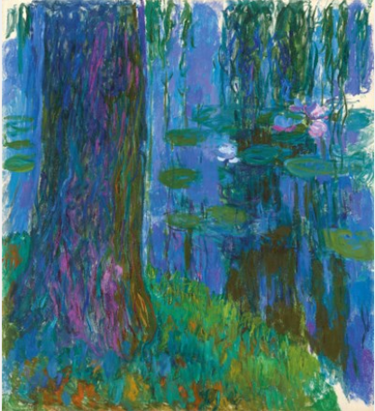
At Christie’s February 27th Sale:
Lot 11
— Claude Monet (1840-1926)
Saule pleureur et bassin aux nymphéas [Weeping willow and pond with water lilies]
stamped with signature ‘Claude Monet’ (Lugt 1819b; lower left)
oil on canvas
78 1/2 x 70 3/4 in. (199 x 180 cm.)
Painted in Giverny in 1916-1919.
Estimate “upon request,” meaning: If you have to ask, you can’t afford it.
29 Jan 2019

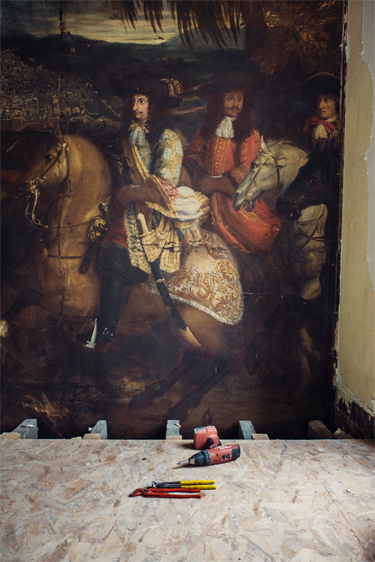
In Paris, renovation work for a new retail store wound up revealing a treasure concealed within the wall. NYT
Alex Bolen, the chief executive of Oscar de la Renta, planned to have his new store in Paris open around this week, just in time for the couture shows. He planned to have a presence in the city even if he didn’t have a show. He had it all figured out.
Then, last summer, in the middle of renovations, Mr. Bolen got a call from his architect, Nathalie Ryan.
“‘We made a discovery,’†he remembered her saying. On the other end of the phone, Mr. Bolen cringed. The last time he received a call like that about a store, their plans to move a wall had to be scrapped because of fears the building would collapse. He asked what, exactly, the discovery was.
“You have to come and see,†she told him.
So, gritting his teeth, he got on a plane from New York. Ms. Ryan took him to the second floor of what would be the shop, where workers were busily clearing out detritus, and gestured toward the end of the space. Mr. Bolen, she said, blinked. Then he said: “No, it’s not possible.â€
Something had been hidden behind a wall, and it wasn’t asbestos. It was a 10-by-20-foot oil painting of an elaborately coifed and dressed 17th-century marquis and assorted courtiers entering the city of Jerusalem.
“It’s very rare and exceptional, for many reasons,†said Benoît Janson, of the restoration specialists Nouvelle Tendance, who is overseeing work on the canvas. Namely, “its historical and aesthetic quality and size.†…
Demolition was halted to figure out what the painting was and how it came to be in what was about to be a shop. Seeing the aristocrats on horseback and the mosque in the picture, Mr. Bolen said, visions of Crusaders and Knights Templar began to dance in his head. “I think maybe I have seen too many movies,†he said. …
So when the painting was found, and it became clear Mr. Bolen would have to talk to the building’s owners, whom he had never met (the lease had been negotiated through a broker), his relative was able to make the introductions. Another de La Rochefoucauld, who happened to work at the Louvre, got a recommendation for an art historian: Stephane Pinta of the Cabinet Turquin, an expert in old-master paintings.
Mr. Pinta determined that the painting was an oil on canvas created in 1674 by Arnould de Vuez, a painter who worked with Charles Le Brun, the first painter to Louis XIV and designer of interiors of the Château de Versailles. After working with Le Brun, de Vuez, who was known for getting involved in duels of honor, was forced to flee France and ended up in Constantinople.
Mr. Pinta traced the painting to a plate that was reproduced in the 1900 book “Odyssey of an Ambassador: The Travels of the Marquis de Nointel, 1670-1680†by Albert Vandal, which told the story of the travels of Charles-Marie-François Olier, Marquis de Nointel et d’Angervilliers, Louis XIV’s ambassador to the Ottoman Court. On Page 129, there is a rotogravure of an artwork depicting the Marquis de Nointel arriving in Jerusalem with great pomp and circumstance — the painting on the wall.
But how it ended up glued to that wall, no one knew, nor why it was covered up. There was speculation that maybe it happened during World War II, given the setting. It could be “a fog-of-war issue,†Mr. Bolen said.
RTWT
23 Jan 2019
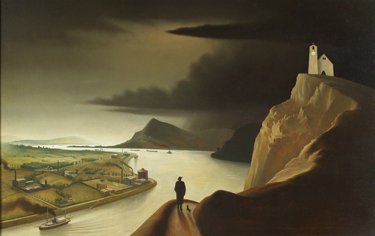
Franz Sedlacek, Industrielandschaft.
Franz Sedlacek (1891–1945) was an Austrian painter who belonged to the tradition known as “New Objectivity” (“neue Sachlichkeit”), an artistic movement similar to Magical Realism. He served as an officer in the German Army during the Second World War, fighting at Stalingrad and in Norway. He disappeared somewhere in Poland in January of 1945.
19 Nov 2018

Japan. Edo period.
1 1/2” – 3.8cm
A miniature Furuyaishi rock, the grey stone of the mountain riven by a wide white torrent and a narrow waterfall. With a hardwood stand and a box inscribed ‘Waterfall Rock’.
Brandt Asian Art
04 Nov 2018
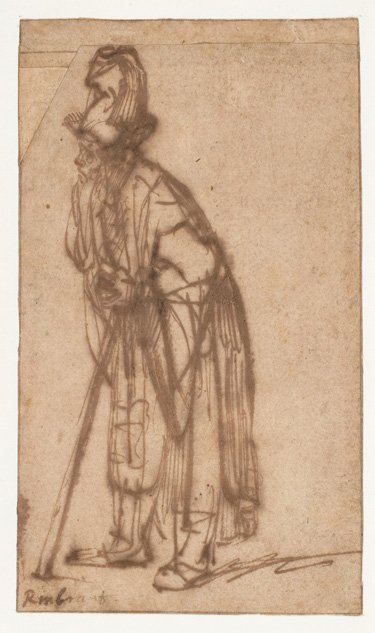
Rembrandt, Old Man Leaning on a Stick, 1632-1635, Robert Lehman Collection, Metropolitan Museum.
01 Nov 2018
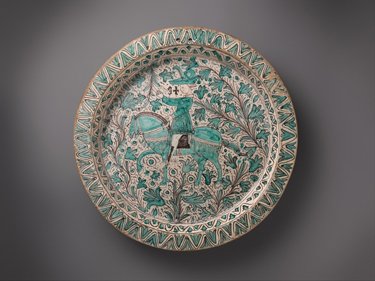
Large Dish
Date: ca. 1420
Geography: Made in Florence or its vicinity, Tuscany, Italy
Culture: Italian
Medium: Tin-glazed earthenware
Dimensions: Overall: 27 1/4 x 3 3/8 in. (69.2 x 8.6 cm)
Classification: Ceramics
Credit Line: Fletcher Fund, 1946
Accession Number: 46.85.1
07 Oct 2018


—————————–
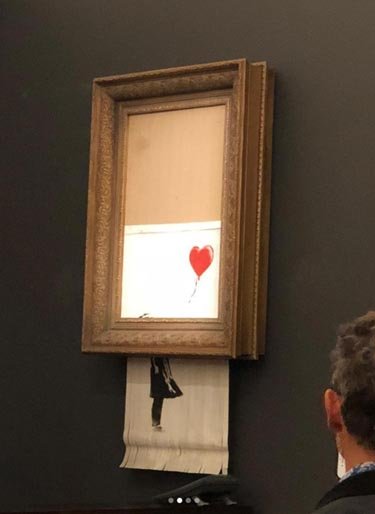
Hyperallergenic:
A Banksy artwork “self-destructed†at a Friday night Sotheby’s auction in London.
“Girl with a Balloon†(2006) was the final lot of the evening sale at Sotheby’s and ended things off with an impressive final price of £953,829 (~$1,251,423), or £1,042,000 with buyer’s premium (~$1,367,104). Maybe people should’ve suspected something was suspicious when the artwork sold for the exact same figure as the artist’s previous auction record in 2008.
Robert Casterline of Casterline Goodman gallery was in attendance and told Hyperallergic what happened next. He explained there was “complete confusion†and an “alarm inside the frame started going off as the gavel went down.â€
“[It] sold for over a million dollars and as we sat there…the painting started moving,†he said, and added that the painting’s frame, also made by Banksy, acted as a shredder and started to cut the canvas into strips. “[It was] all out confusion then complete excitement,†he explained.
Anny Shaw of the Art Newspaper spoke to Alex Branczik, the auction house’s head of contemporary art for Europe, who seemed as surprised as anyone. “It appears we just got Banksy-ed,†he said immediately after the sale. He is arguably the greatest British street artist, and tonight we saw a little piece of Banksy genius,†he said, adding that he was “not in on the ruse.â€
Shaw also reports that there was speculation “that the elusive artist had himself pressed the button that destroyed the work.â€
But is the work destroyed? Or is it transformed? Even Branczik isn’t sure. “You could argue that the work is now more valuable,†Branczik said.
RTWT
——————————-
05 Jun 2018


Julie Mehretu, The Mural, 2010, Goldman Sachs, New York.
“Great nations write their autobiographies in three manuscripts—the book of their deeds, the book of their words, and the book of their art. Not one of these books can be understood unless we read the two others; but of the three, the only quite trustworthy one is the last.”
— John Ruskin, St. Mark’s rest; the history of Venice (1877).
James McElroy leafs through “the book of their art” of today’s community of fashion elite and shudders.
In 2010, Goldman Sachs paid $5 million for a custom-made Julie Meheretu mural for their New York headquarters. Expectations are low for corporate lobby art, yet Meheretu’s giant painting is remarkably ugly—so ugly that it helps us sift through a decade of Goldman criticisms and get to the heart of what is wrong with the elites of our country.
Julie Mehretu’s “The Mural†is an abstract series of layered collages the size of a tennis court. Some layers are colorful swirls, others are quick black dash marks. At first glance one is struck by the chaos of the various shapes and colors. No pattern or structure reveals itself. Yet a longer look reveals a sublayer depicting architectural drawings of famous financial facades, including the New York Stock Exchange, The New Orleans Cotton Exchange, and even a market gate from the ancient Greek city of Miletus.
What are we to make of this? Meheretu herself confirms our suspicion that there is no overarching structure to the piece. “From the way the whole painting was structured from the beginning there was no part that was completely determined ever. It was always like the beginning lines and the next shapes. So it was always this additive process,†she said in an Art 21 episode. …
Scottish philosopher Alasdair MacIntyre gave a lecture to Notre Dame’s Center of Ethics and Culture in 2000 about the compartmentalization of our ethical lives. He argued that in modern Western culture these different areas are governed by different ethical norms and standards. The example he gives is how a waiter at a restaurant acts differently in the kitchen than in front of the customer. In the kitchen it is normal to yell, curse, and touch the food with his bare hands; none of this would be appropriate in front of the customer. And when the waiter goes home, his personal life is dictated by a further third set of norms. Or consider how the ethics of lying are treated differently during a job interview versus at home or at a law office. Like the painting in the Goldman Sachs lobby, our ethical lives seem to be made of different layers that don’t connect. Our culture no longer shares a single ethical narrative, and so our choices are not weighed against a standard that’s consistent. Rather, people ask that their choices be accepted simply because they were made. When the bankers over-leveraged prior to 2008, they made a series of compartmentalized choices without considering the larger societal implications. They and the art in their lobby are the same.
I do not think the bankers at Goldman spend each morning scrutinizing their lobbies for larger ethical implications. Nihilistic art does not create nihilistic bankers. Yet both the elites of art and the elites of finance come out of the same culture. Both are indicative of where we are as a society. The Occupy Wall Street crowd may call Goldman a vampire squid wrapped around the face of humanity, but they never apply the same harsh rhetoric to our cultural institutions. A decade after the recession, our contemporary high art is more nihilistic than ever. This informs all areas of our culture. When powerful institutions are discussed we often critique in terms of isms: capitalism, liberalism, managerialism. We forget to mention that our institutions are made up of individuals who share the same culture that we all do. IRS auditors listen to Katy Perry. Federal judges watch comic book movies. The spies at the CIA read Zadie Smith novels. Our morality is informed in part by the art, both high and popular, that surrounds us.
RTWT
09 May 2018


Steve Bodio linked this two-year-old Charles Schultz interview with the great Sporting author/painter Russell Chatham. Chatham has interesting things to say about money, art, and fly fishing.
[Money:]
Charles: You mention Monet in your “Advice for a Young Artist.†Most of his life he was miserably poor.
Russell: When I started painting as a kid, you have to remember there was no T.V., there were no diversions. Down on the ranch, we didn’t even have a radio. I just loved painting, and never thought of it as a profession. When I began to think, “This is what I am going to do,†I had to grit my teeth and accept that I was going to be dirt poor my whole life. “If that is not okay with you, you better not do this.â€
Charles: This idea that if you want to have integrity you have to prepare to be poor is lost, more so somehow as the economy declines. Arthur Miller said the Great Depression made everyone more voracious. The less there was, the more bitter the contest for it.
Russell: No, they’re not prepared to be poor. And, quite frankly, it was an absolute fluke in my case. I’m not a businessman. If any money crosses my path, it is gone faster than butter in an oven. I have no savings, no retirement. I have whatever’s in my wallet. To a lot of people that would be frightening. …
[Art:]
Charles: Tell me about Robert Hughes. He is sometimes regarded as an opponent of contemporary art, but he really wasn’t.
Russell: He was contemptuous of phonies. You know anyone can do anything they want, as long as they believe in it. That’s the key. Insincerity is the ultimate sin. The problem is the contemporary art world lends itself so much to insincerity.
Charles: Fairfield Porter writing for Art News back in the ’40s and ’50s made a point about art requiring two elements: that it communicate and that the artist have a moral commitment. I think back to what you said: “They have to believe it.â€
Russell: It’s your own personal code of ethics—your honesty with yourself. You don’t confront that very much in the mainstream art world/media complex. They don’t talk about that, especially about any artist who has been pumped up to the point that they are being sold for millions at auction, an auction that is supposed to reflect the value of that work of art. But at that point they aren’t interested in a critical assessment of artistic merit. Where there are hundreds of works by an artist, perhaps living or more probably dead, which are worth half a million dollars or more, there isn’t going to be a critical discussion. There is too much money involved.
Charles: Hughes said this created a “blinding effect†that prevented one from seeing the object because of its monetary value.
Russell: That’s a good way to put it. People are so impressed by money, the price of things, that they are blinded. Somebody wrote a check for that?! I saw something, oh, 15 to 20 years ago in Chicago, when they used to have a big show at the Navy Pier. Artists came from all over the world. I used to go to Michigan to hunt with Jim Harrison, but I always stopped in Chicago for this show. Well, for a couple of reasons: the Art Institute, and Midwesterners. You can’t sit down in a bar there for more than 30 seconds before one of these guys is talking to you and asking who you are. They are curious people, and there is great food and music. But the Navy Pier show would have plenty of good things, and some not so good. A mix.
Anyway, I’m walking down this hallway and this guy has got his booth. He’s got a gallery in Chicago I think, and he’s got this painting, maybe five or six feet square. It was just this completely nondescript abstraction, and not a known artist—not that I know everybody—but not a famous artist at all. There was a woman standing there, and the guy who had the booth is explaining why this was a great painting. I thought, “I gotta hear this.â€
I pretend to be looking at something else, while he goes on and on and on. And I am thinking, “You gotta hand it to this guy: this bullshit is really pretty convincing.†He is talking about its museum-quality status, and it is the dumbest painting I’ve ever seen. Well pretty soon, this lady is putting down her purse, taking out her checkbook, and she is writing a check. Oh my god! So they complete the transaction, and go off and sit down together at his desk. And I went up to the painting and looked at the sticker: $600,000.00. Boy, he had the gift, I tell ya.
Charles: Haha!
Russell: You could buy a Winslow Homer for less than that! …
[Fly Fishing:]
Charles: I have a friend in upstate New York who is a painter and a fisherman. When I asked him about you years ago, he immediately said that you were the first to write about fly fishing with libido. Not, “Oh nature is so beautiful, how peaceful I feel,†but a hard-partying bunch of guys fishing.
Russell: It is funny. There is a whole fly fishing world and a lot of people write about it. But it is a pretty dipshit thing when you take it apart. There are aspects to it that are nice, but it can really get touchy feely. You know, “Oh, I just like to be out there all day and listen to the birds and smell the roses in the air.†Fuck that! I’m out there to catch fish. If I’m gonna go bird watching, I’ll take my binoculars and go bird watching. I’m not gonna go fishing. When I’m fishing my mind is on one thing and one thing only, and that is where my fly is.
Charles: This same friend hated a film from the early ’90s, not on its merits necessarily, but that it caused a phenomenon. Every banker in New York City put a “Trout Bum†sticker on the back of his Lexus, drove north and invaded all of his streams.
Russell: It changed the face of fly fishing. It was called “A River Runs Through It.†It was based on a very good book by a guy called Norman McLean, who was from Montana. The movie was filmed in Livingston while I was there. It created a fly-fishing hysteria. Suddenly, this thing that was pretty personal—nobody went fly-fishing unless you were crazy—now, as you said, every stockbroker was a fly fisherman. It crowded things up pretty good. When I saw it, I couldn’t believe it. These people really don’t understand fishing. They aren’t naturals who started when they were 8 years old. They haven’t been crazed and insane about it their whole life.
On the Madison River, where I normally didn’t fish, didn’t need to, I drove over one day and couldn’t believe my eyes. I saw, on a stretch of maybe 20 miles, a thousand parked cars. The guys were fishing as close as from me to you, five, six feet apart. Not only that, but most of them had hired guides. So there are two guys—the guy and his guide! And the guide has a boat, which bounces down through the rocks, and then they stop and fish. That’s not fishing. Nobody’s catching anything, or when they do, it is tiny. Do they actually think this is fishing? Fishing is a solitary activity. It is a big deal. This ain’t it.
Charles: What about environmentalism? We accept industry and empire as given, and then weep over trivia.
Russell: They’re not environmentalists—they’re assholes. You could blame that criminal destruction of the oyster farm on this “environmentalism.†A lot of these people live in cities, and drive out to the country once in a while. They don’t know what is going on here. They look at nature out of the car window as they are driving by it. That’s just another form of watching T.V.
All this talk about the restoration of creeks and rivers, restoration of salmon: it is never going to happen. For example, the wine industry dried up the Russian River. Are we going to reverse the wine industry? They have too much money and are too big. The wells have dropped the whole water table. When you do that in a valley, you drop the water table up at elevation, too, which causes your tributary streams to dry up. And that is the end of your steelhead and salmon.
They had this problem on the Eel River. The dope growers dried up the whole river. Nobody could believe it. It is an “illegal†activity, but nobody is doing anything about it. There is no enforcement. Of course, they were also focused on how “bad†marijuana is. Nobody ever O.D.’ed on it.
RTWT

Feeds
|














